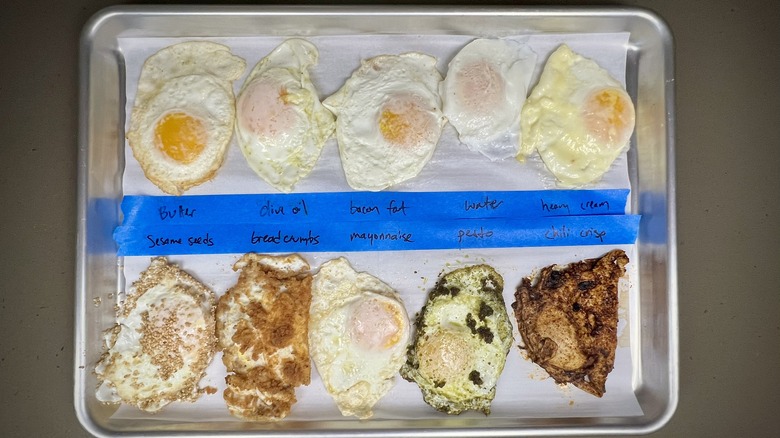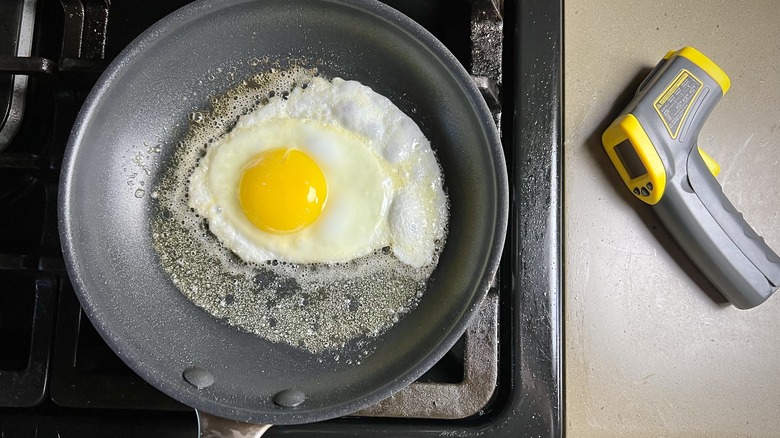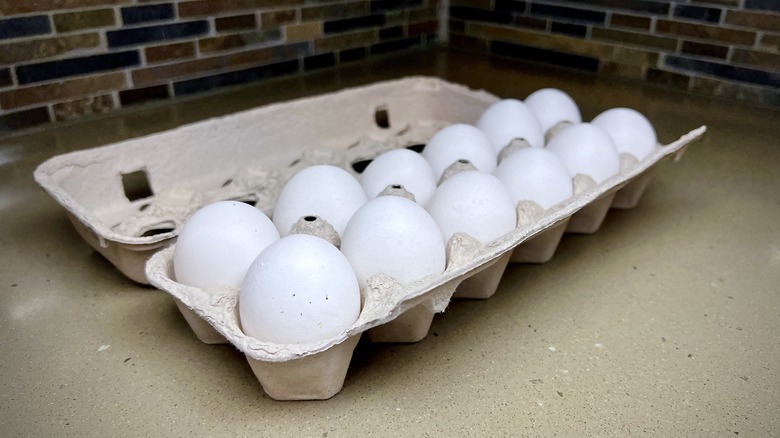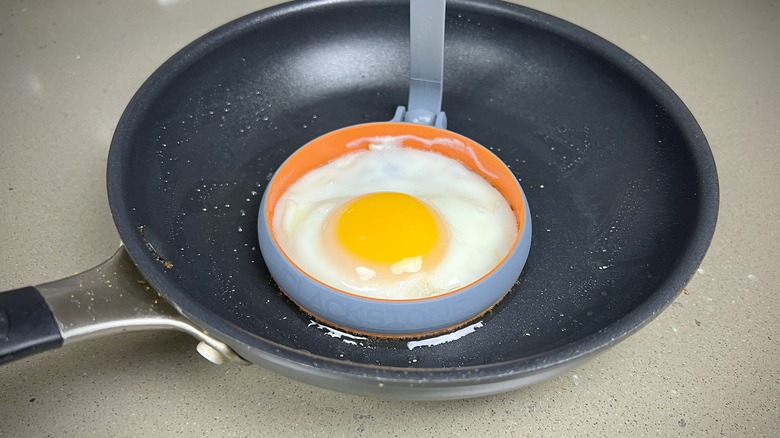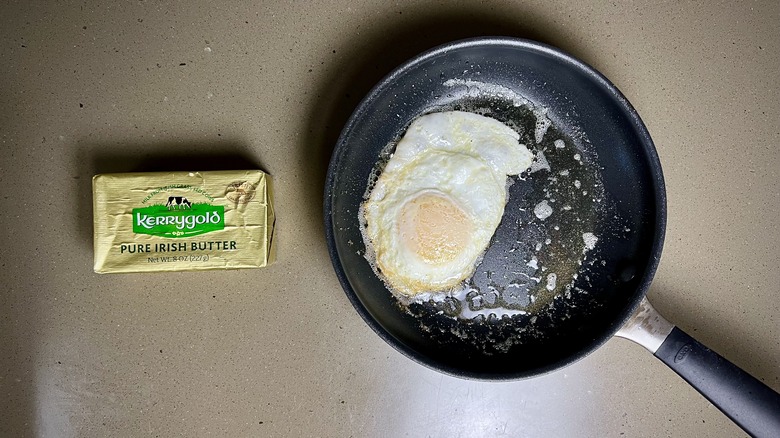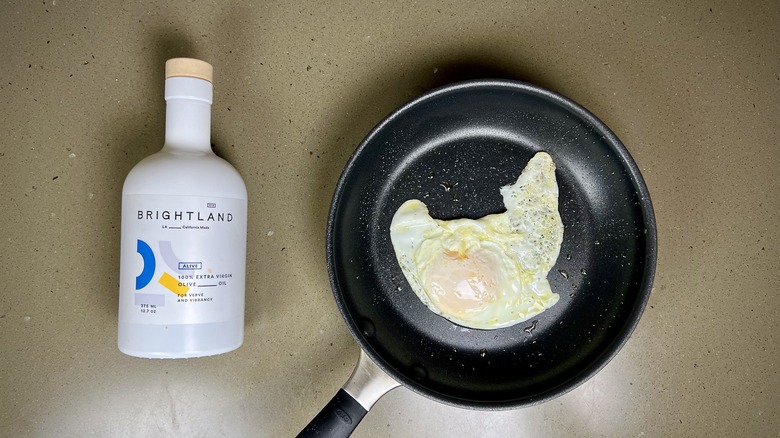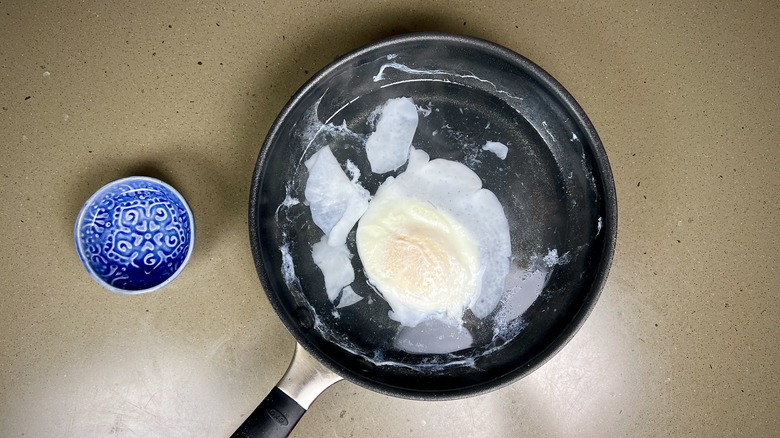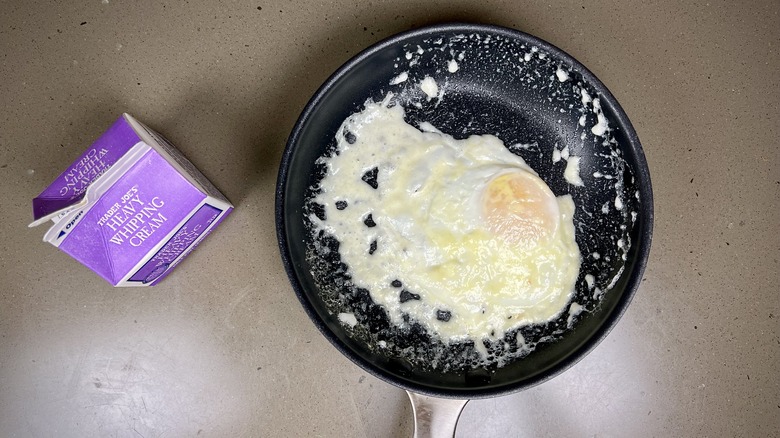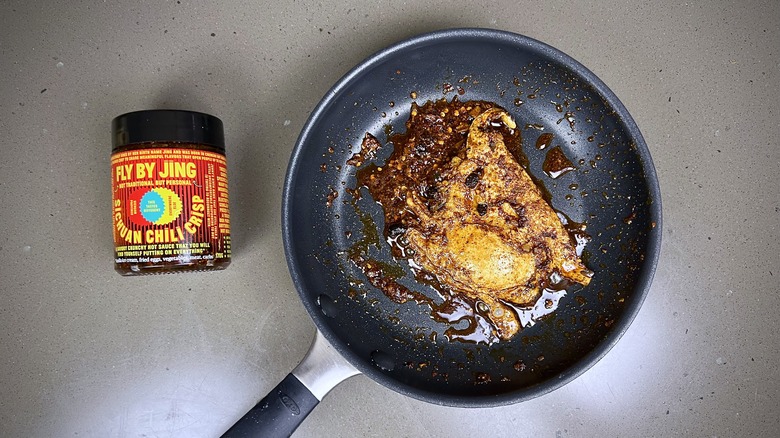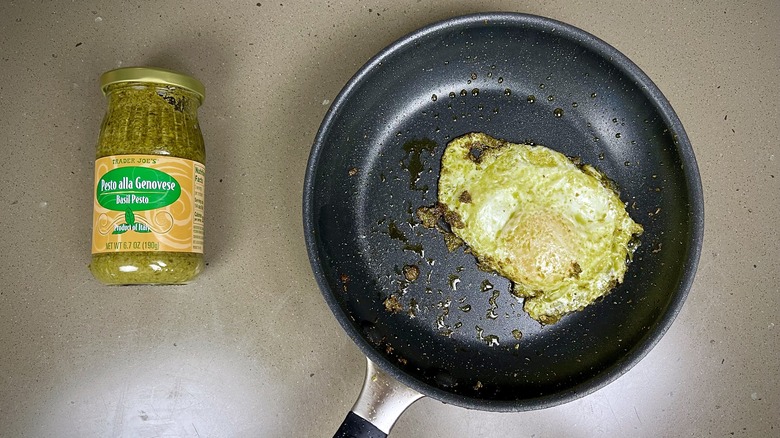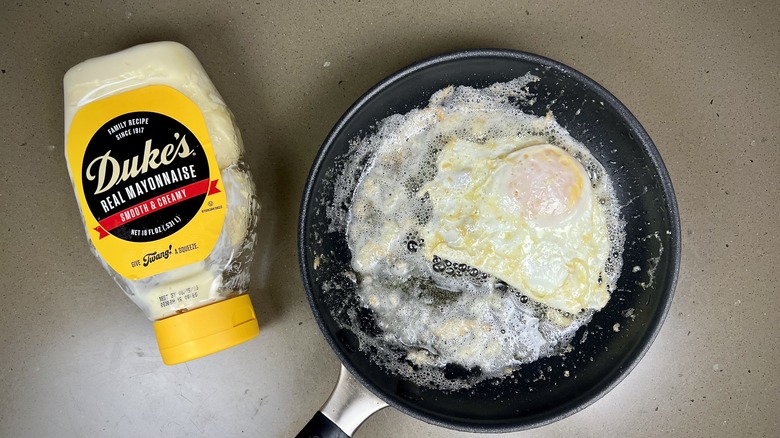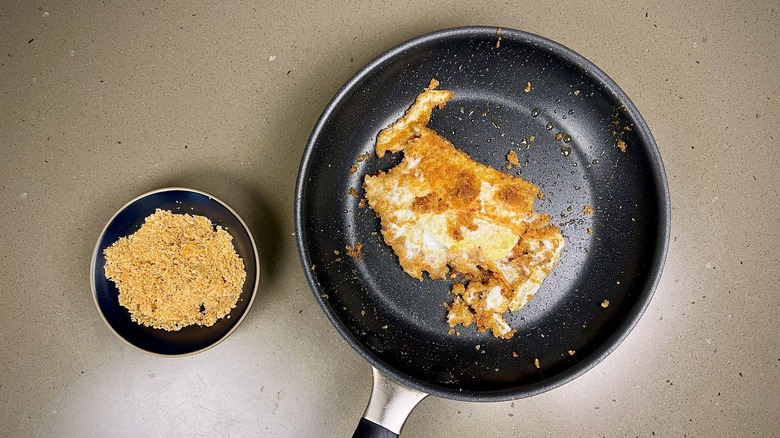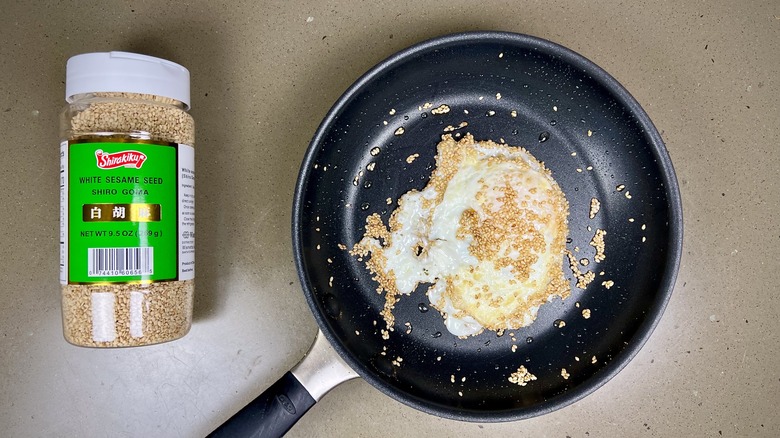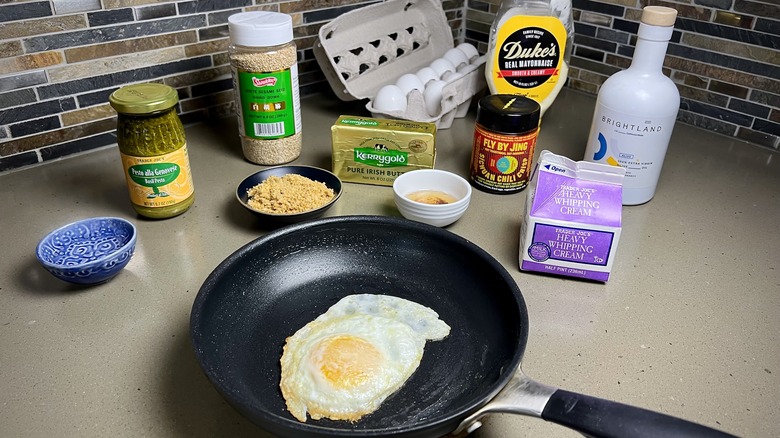We Tried 10 Methods To Cook Fried Eggs And Found The Best One
There's something undeniably good about runny eggs. The way a fried egg gives way to an oozing yolk when pierced with a fork just gets us every time. Its decadent, rich flavor and smooth, velvety texture complement so many dishes, from the humble avocado toast to a comforting bowl of roasted vegetables. However, the art of frying eggs can be deceptively challenging, and accidentally breaking the yolk can quickly spoil the experience.
We wondered if changing the cooking medium would help make the process easier, so we tested 10 different methods. To make sure the tests were standardized, we cooked every egg in an 8-inch nonstick pan. For the methods that used a cooking fat, we preheated the oil to 300 degrees Fahrenheit (as measured with an infrared thermometer). For those that used liquid, we brought the liquid to a consistent simmer. When the eggs were cooked to over-medium (fully set whites and runny yolks), we assessed each dish on ease of cooking, taste, and appearance. Did we find the way to make your fried eggs even better? We think so!
The best pan for making fried eggs
We generally recommend nonstick pans for making fried eggs. These pans are lightweight, heat up quickly, and distribute heat evenly. Because nonstick pans are coated with a surface designed to make food slippery, the chances are pretty good that your eggs won't stick to the bottom of the pan, causing the yolk to spill out before it's pierced with your fork. You'll want to consider a few things when choosing between ceramic and Teflon pans (the two most popular forms of nonstick cookware). They both utilize chemical coating, so avoid using either pan over high heat. You also don't want to dry heat nonstick cookware, as it can release toxic fumes into the air.
If you don't have a nonstick pan, you can use a well-seasoned cast iron or carbon steel hybrid pan. In general, you'll want to use more cooking fat with these pans than their nonstick counterparts so the oil can create a slick layer that allows the egg to move freely. While some people have found success seasoning stainless steel pans to make them nonstick, we find these pans are the trickiest to use. We recommend using another pan unless you have a lot of egg-flipping experience.
Can you make fried eggs without a frying pan?
There are several ways to make fried eggs without a frying pan. First, you can use the microwave, as seen in a viral TikTok video. After cracking the egg on one paper plate, cover it with the other and cook it on high for 50 seconds. Alternatively, you can make fried eggs in the air fryer. After lightly greasing a pan liner, cook the eggs between 320 and 350 degrees Fahrenheit for five to seven minutes (depending on the air fryer). Finally, you can fry eggs in the oven using a muffin tin, an oven-safe ramekin, or directly on a sheet pan.
The problem with all these methods is that the eggs rarely turn out as good as on the stovetop. A stovetop-fried egg has the perfect balance of textures, producing soft whites and jiggly, runny yolks. Other cooking methods require some work to keep the whites from getting rubbery. It's also easy for the yolks to overcook or for the egg to turn an unappealing brown color.
The trick to keep fried eggs from spreading
When you crack an egg into a hot frying pan, the egg whites inevitably pool around the pan and spread, creating a fried egg that looks like it has a tail. This affects the egg's appearance and also keeps the egg from cooking evenly. A thin egg white end will cook more quickly than the center, so it can crisp up and become dry.
If you're looking for a perfectly circular fried egg, there are a few tricks to keep the egg white from spreading. The key is to first preheat the pan with a little oil, ensuring that the whites will start to firm up as soon as they touch the pan. Then, place a silicon ring in the center of the pan. To avoid buying another cooking gadget, you can also use the veggie trick to prevent your fried eggs from spreading (a ½-inch slice of onion or bell pepper instead). Then, crack the egg into the center of the ring. The whites will be contained inside the circle, assisting you in achieving a perfectly cooked fried egg.
Method 1: Butter
Once we determined that the stovetop was the best cooking method, we set about cooking our eggs. The first test was a classic: Add a teaspoon of butter to a nonstick pan and heat it over medium heat. The butter took a minute to melt, but it spread out beautifully, reaching every edge of the pan without us having to swirl the pan for an even coating.
The butter smelled incredible as it bubbled and sizzled, and the egg cooked beautifully. This egg's rich, buttery flavor and intoxicating aroma made it clear why butter is a go-to egg cooking method for most people. We used salted butter for our test — a choice we suggest for anyone wanting to add an extra layer of seasoning to the egg. You do have to be careful not to heat the pan too high with this one, though. Butter has a relatively low smoke point, and it will begin to smoke between 302 to 350 degrees Fahrenheit. That not only adds an unpleasant flavor to the fried egg, but it can also add an unappealing brown color to the edges of the whites if the milk solids start to burn.
Method 2: Olive oil
We chose Brightland olive oil for our next test. This olive oil has a high smoke point of 410 degrees Fahrenheit, so we knew it could hold up to the medium heat used for frying eggs. The benefit of oil over butter is that it is already liquid at room temperature, so we didn't have to wait for the oil to melt. The teaspoon of olive oil didn't spread as easily as the butter, though, so we had to shake the pan to ensure the entire surface was coated.
The egg pooled out a little bit on this one, creating a long tail, and we had to continue to shake the pan as the egg cooked to prevent pockets of ungreased surface under the egg white. But, all in all, this cooking oil did its job and kept the egg from sticking. We loved the grassy flavor the olive oil imparted, and we thought this one would be good when paired with sourdough toast, herbaceous roasted potatoes, or an acidic chimichurri sauce. Olive oil would be our top choice if we wanted to make a crispy fried egg, a cooking technique that cranks up the heat to give the egg a crunchy texture on the bottom.
Method 3: Bacon fat
This method required a little preparation, as most of us don't have bacon fat on hand. (Although, after doing this test, we absolutely should because this egg was delicious!) A single piece of bacon yielded a heaping tablespoon of fat, although results may vary depending on the brand and the thickness of your bacon. That was more than enough to fry an egg, as we only needed a teaspoon to coat the pan.
The fat spread effortlessly as the pan preheated, and it didn't seem to pool in the corners as much as the olive oil. We were worried that the egg would brown in this fat, but it was actually one of the more gorgeous eggs in the group. It was worth straining the bacon fat through a fine mesh strainer, wiping out the pan, and starting fresh instead of adding the egg directly to the pan used to cook bacon. The latter would attach little bits of crispy bacon to the egg, which may burn during the additional cooking time.
Method 4: Water
Most of us have heard of poaching eggs in water, but we had never heard of frying eggs in water. The idea here is that the water will keep the egg from sticking to the pan. As a bonus, it's also a fat-free cooking method. So we added ¾ cup water to our 8-inch skillet (enough to create a ½-inch layer of water). After bringing the water to a simmer, we cracked the egg, reduced the heat to medium, and covered the pan loosely with a lid. After about two minutes, the egg was ready to flip.
Unfortunately, this was our least favorite egg in the group. The water diluted the flavor, so it wasn't as rich as the other cooking methods. The egg whites also pooled out as soon as the egg hit the pan, and most of them detached from the main egg as the water simmered. The egg was also difficult to flip because the water added momentum, and it sort of bobbed around as we tried to flip it over.
Method 5: Heavy cream
This method is the polar opposite of the water technique: Instead of reducing the fat content, this one ramps up the richness by using heavy cream. We poured three tablespoons of heavy cream into the pan and cracked the egg directly into the liquid. To keep the egg in the middle of the creamy mixture, we had to tilt the pan as the liquid simmered. When the cream started caramelizing around the edges, we flipped the egg and cooked it for a few minutes on the second side.
This method felt extremely weird, and we worried that the cream would over-reduce or burn. But the result was pretty incredible. The tilt helped large bubbles of cream to move over the egg as it cooked, pre-cooking the yolk. That made the egg easier to flip than the other methods. The reduced cream had a bit of an alfredo vibe, adding a big boost of sweetness. Next time, we'd want to spruce up this ultra-rich egg by adding bold flavors like rosemary, garlic, and red pepper flakes. This one also doesn't look fantastic (the cream looks a little clumpy), so we'd want to play around with how it's cooked or served to make it more presentable.
Method 6: Chili crisp
If you're into chili crisp — a spicy, oil-based condiment made with fried chiles and other savory ingredients — you probably already know it's good on everything. It's fantastic as a dipping sauce for dumplings, swirled into noodles or ramen, or drizzled over breakfast eggs. So it was a no-brainer to add it to our methods of cooking fried eggs.
The viral TikTok way to make these fried eggs is to add scallions and soy sauce to the pan, but we wanted to keep things plain. So we added one tablespoon of chili crisp (the oil plus solids) to the middle of the pan and turned on the heat. The oil needed a little coaxing to spread out, and we found the egg whites pooled out around the warm oil. Tilting the pan was necessary so the egg and chili crisp stayed together. Although the bits of chili pepper, garlic, and scallions made it a little hard to flip the egg, we eventually got the job done. The end result was a gorgeous, bright-red egg with a fantastic texture and an incredible flavor. You do have to like spicy food to like this one, though. A whole tablespoon was a lot of chili crisp, and the heat was definitely present.
Method 7: Pesto
Pesto eggs were another idea that came to us from a viral TikTok video, where they were used to spruce up avocado toast. We were game to give it a try, but we weren't sure if the pesto would keep its appealing green color as the eggs cooked. The tablespoon of pesto was difficult to spread around the pan, and it started spitting oil at us as soon as the pan got hot. We added the egg as quickly as we could and covered the pan with a lid to keep the volatile pesto from destroying our kitchen and burning our arms.
Difficulties aside, the flavor here was amazing. The cheese in the pesto browned and provided a pleasantly crunchy texture to the fried egg. While the egg was browned in a few spots, we were impressed overall with the vibrant color. If you're looking for green-eggs-and-ham vibes, this is the way to go. This egg would also taste fantastic on toast or over a bed of roasted potatoes.
Method 8: Mayonnaise
To say we were apprehensive about this method is an understatement. We're okay with spreading this eggy condiment onto a piece of bread to resolve the debate over which makes a better grilled cheese (butter vs. mayo). But putting a tablespoon of mayonnaise directly into a pan and turning on the heat is quite another thing. In the name of science, we forged ahead, and we were pleasantly surprised.
With a little nudging from a rubber spatula, the mayonnaise spread into an even layer, coating the whole pan and foaming lightly (just like the butter from the first test). There were some stubborn clumps that did not want to break up, and you'll want to be more fastidious than we were: We thought they would dissolve as the egg cooked, but they hardened into savory bites that floated around the pan. All in all, this method worked, and the mayonnaise did keep the egg from sticking. The egg turned out a little oily, but it would be a fantastic option for a sandwich. The only caveat is that the smell was weird, so mayonnaise haters should really avoid this option.
Method 9: Breadcrumbs
This method comes to us from Zuni Cafe in San Francisco, a restaurant famous for creating seasonally focused, hybrid dishes fusing California cuisine with global inspiration. To pull off their eggs fried in breadcrumbs, we preheated two tablespoons of breadcrumbs with a tablespoon of oil until the crumbs started to bubble and spread. The egg went directly on top, and it was a bit of a struggle to keep the egg whites from spreading beyond the pile.
The result was pretty messy, and the egg needed a lot of coaxing with a rubber spatula to flip over. It fell apart a little, but we eventually got there, revealing a breathtaking layer of crisp breadcrumbs. It may not look like our best egg, but the texture and flavor were there. Next time, we'd like to add a little more oil to the mix to keep the egg from sticking. We would also consider adding a few tablespoons of Parmesan cheese to this one to give it a frico vibe.
Method 10: Sesame seeds
We found our final method on Instagram, where a video showed about a tablespoon of sesame seeds being heated in an oiled pan. After forming the seeds into a large circle, the egg is cracked directly onto the pile. More sesame seeds are sprinkled on top before the seed-packed egg is served on a piece of toast with labneh, harissa, and arugula.
After the breadcrumbs, we were a little apprehensive about cooking an egg on loose material, but we went for it anyway. Using 1½ teaspoons of oil underneath the sesame seeds was enough to keep the egg from sticking. This egg was so crunchy, and it had a remarkably toasty, nutty flavor that worked with the rich egg yolk. It reminded us of the chili crisp egg but without the spice. This one would pair well with Middle Eastern flavors, Asian flavors, or salads served with a fried egg.
Verdict: The fried egg method that tastes the best
After considering everything, were we able to definitively determine the ultimate fried egg technique? Each method had its own appeal, and the only method that fell short was the water. Its lackluster flavor and unappealing appearance made it unimpressive, and flipping it was no easy feat. If we had to choose a top pick for everyday fried eggs, the butter definitely won. It evenly coated the pan and imparted a delicate but familiar richness to the eggs. Bacon fat was a close second (and a good choice for dairy-free diets), but you have to have bacon fat on hand.
For a fancy brunch, we'd recommend one of the colorful options. Chili crisp was a top contender because it fused color, texture, and flavor, but pesto came in a close second (and didn't bring along the tongue-numbing spiciness). We loved the richness of the eggs cooked in heavy cream, but this method needs a little experimentation to get the appearance just right.
